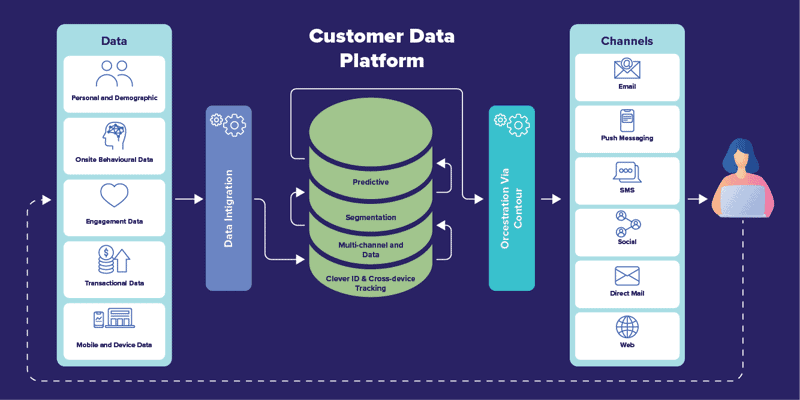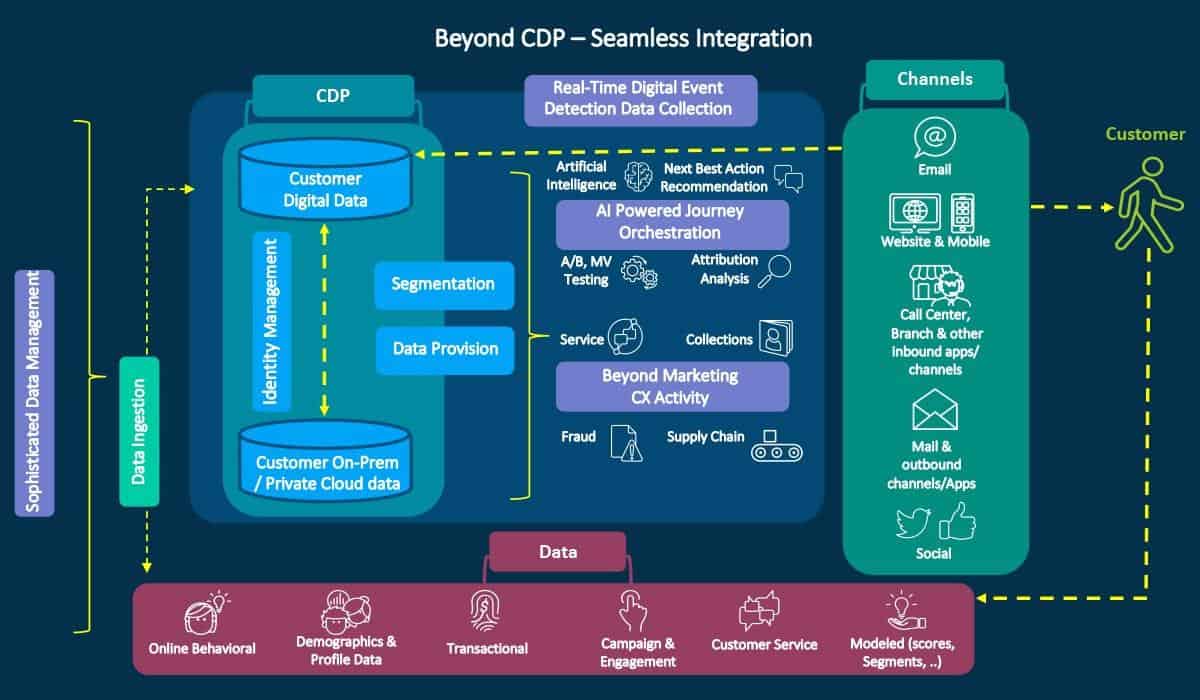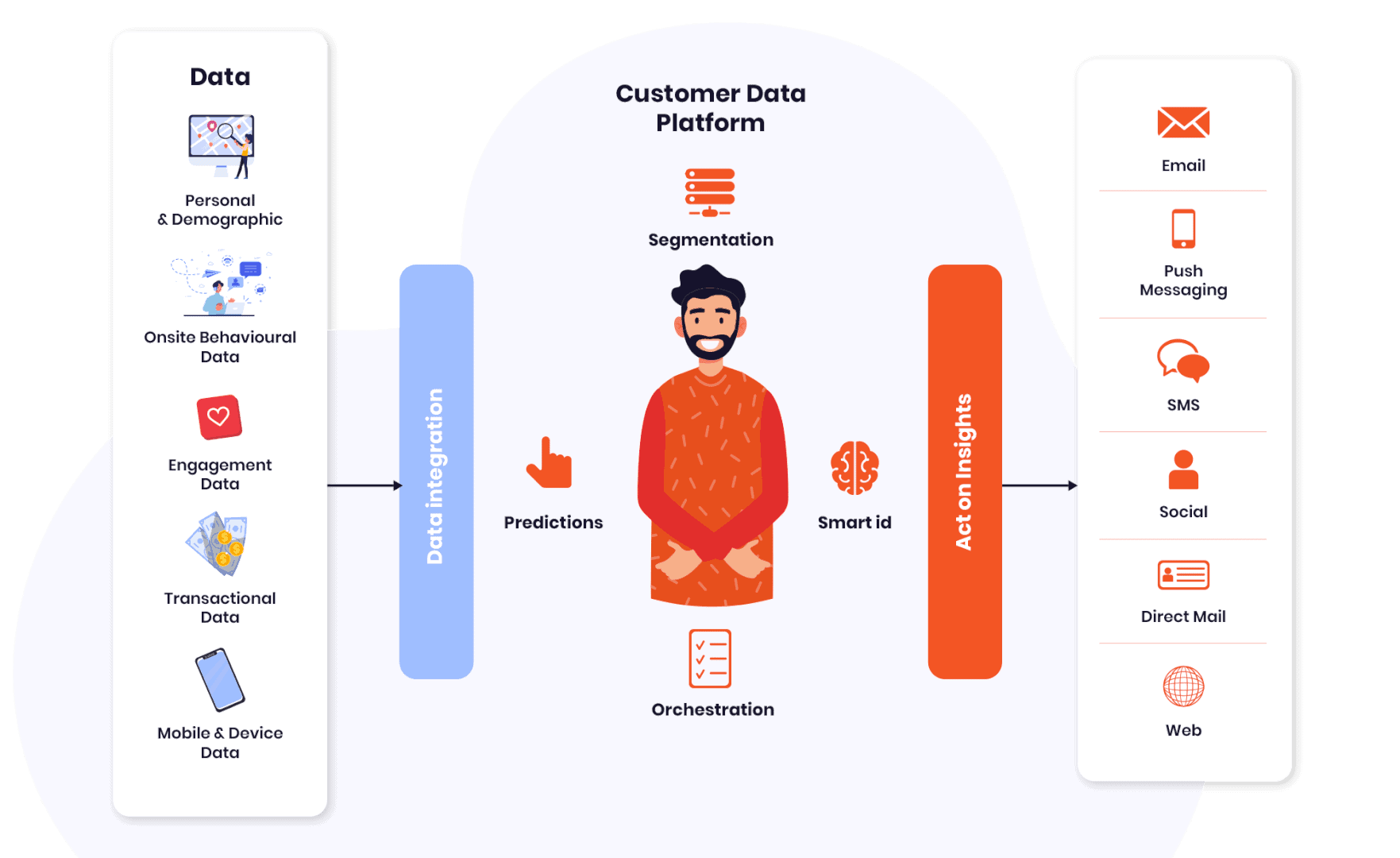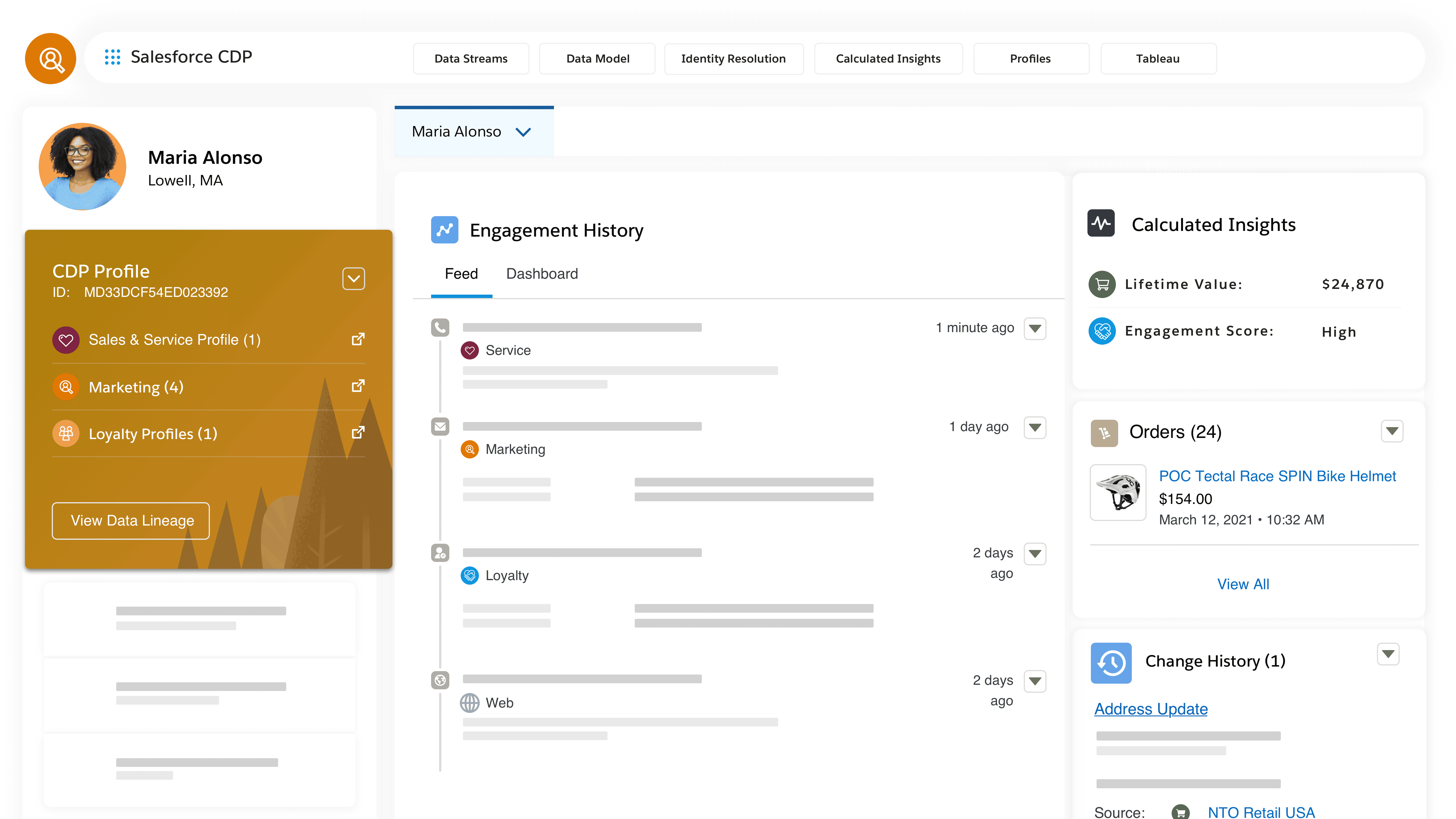The Future of Customer Data Platforms and Salesforce CDP
Discover the latest trends and insights on Customer Data Platforms and Salesforce CDP. Learn how these technologies are shaping the future of customer data management.

Customer Data Platforms (CDPs) have garnered immense popularity as enterprises strive to gain deeper insights into their customers and enhance engagement. Among the top-tier solutions in this domain is Salesforce CDP, which boasts diverse cutting-edge features and capabilities designed to facilitate customer data's seamless collection, unification, and activation. Within the confines of this article, we shall delve into the most recent trends and enlightening perspectives surrounding CDPs and Salesforce CDP, thereby elucidating the profound impact these technologies wield over the forthcoming landscape of customer data management.
Customer Data Platforms, often known as CDPs, provide marketing businesses with a centralized and comprehensive data repository for their customers' information.
Salesforce introduced its Customer Data Platform (CDP) in May 2021. CDP is an improved product version initially known as Customer Audience 360 (CA360). Slightly more than a year later, on June 3, 2018, at Dreamforce '22, Salesforce Genie was introduced. This takes the capabilities of Salesforce CDP and extends the advantages across the "Customer 360," which refers to Salesforce's product line.
CDP is a marketing jargon that has spread like wildfire since its introduction. Please continue reading to learn about the functionality of CDPs, their advantages, and the potential benefits that the Salesforce CDP might bring to your company.
NOTE: While Salesforce CDP is the term that is presently being used the most often for the platform, its previous name was CA360, and its current name is Data Cloud for Marketing.
What is a Customer Data Platform?
A Customer Data Platform, often called a CDP, is a powerful software platform businesses utilize to gather, consolidate, and leverage customer data from diverse channels. This encompasses data originating from online and offline interactions, encompassing website visits, social media engagements, email campaigns, and in-person purchases. CDPs employ sophisticated analytics and machine learning algorithms to construct a unified customer profile, enabling personalized marketing campaigns, heightened customer engagement, and accelerated revenue generation.
Salesforce CDP stands as a leading customer data platform, offering many features and capabilities designed to enhance businesses' comprehension of their customers and foster better engagement. By employing Salesforce CDP, enterprises can amass and integrate customer data from multiple sources, including Salesforce CRM, third-party systems, and offline interactions. In addition, the platform employs advanced analytics and machine learning algorithms to provide an encompassing overview of each customer, encompassing their preferences, behaviors, and purchasing history. This empowers businesses to deliver tailor-made experiences and focused marketing campaigns that bolster engagement and drive revenue growth. Irrespective of whether you operate a small business or a large enterprise, Salesforce CDP is an indispensable tool to unlock the untapped potential of your customer data, propelling your business toward resounding success.

The benefits of using a CDP
Utilizing a Customer Data Platform (CDP) brings forth many advantages for your business. Among the paramount benefits lies the capability to establish a cohesive customer profile, enabling a deeper comprehension of your clientele and personalizing your marketing endeavors. Consequently, this paves the way for heightened customer engagement, elevated conversion rates, and amplified revenue. Furthermore, CDPs streamline your data management processes, mitigate data silos, and enhance the accuracy and uniformity of your data. By and large, embracing a CDP empowers you to maintain a competitive edge and deliver an enhanced customer experience.
Salesforce CDP, a formidable tool, facilitates the attainment of these benefits and beyond. Its cutting-edge data management capabilities enable effortless collection, unification, and activation of customer data across all your channels and touchpoints. Consequently, you can construct a comprehensive 360-degree view of your customers, encompassing their preferences, behaviors, and interactions with your brand. Armed with such valuable insights, you can curate personalized experiences that deeply resonate with your customers, fostering loyalty. Moreover, Salesforce CDP seamlessly integrates with other Salesforce products, such as Marketing Cloud and Sales Cloud, allowing you to leverage customer data across your entire organization. Therefore, if you aspire to elevate your customer experience to unprecedented heights, contemplate harnessing the power of a CDP like Salesforce CDP.
CDPs consolidate all customer data into a unified repository, cultivating a profound customer-centric approach within organizations, leading to heightened intelligence in customer engagement and identifying optimal next steps. This transformation yields a plethora of substantial advantages.
- CDPs equip organizations with the ability to empower marketing teams, enabling them to effectively target the appropriate individuals with the right offerings at the most opportune moments.
- As a result, this typically engenders improved marketing key performance indicators (KPIs), including elevated conversion rates, enhanced return on investment (ROI) derived from marketing expenditures, and amplified revenue stemming from previously untapped marketing and sales prospects.
- Beyond the augmentation of existing marketing campaigns, CDPs also facilitate the discovery of fresh, lucrative audience segments, thereby broadening organizational reach through meticulously targeted initiatives.
- The augmented segmentation capabilities also empower companies to gain valuable insights into campaign performance and optimize strategies for superior outcomes, as this serves as the bedrock for purposeful reporting.
- Lastly, CDPs offer a multitude of supplementary benefits and applications. For instance, they enable centralized customer data management, ensuring compliance with crucial regulations such as Europe's General Data Protection Regulation (GDPR) and facilitating consent management.

The Role of SalesForce in the CDP market
SalesForce, a prominent player in the burgeoning Customer Data Platform (CDP) market, has established itself as a frontrunner with its own cutting-edge CDP solution known as Salesforce CDP. This remarkable offering enables businesses to consolidate customer data from diverse sources, encompassing CRM systems, marketing automation platforms, and third-party data providers. The result is a comprehensive customer perspective that empowers businesses to deliver personalized experiences across all customer touchpoints. Moreover, Salesforce CDP seamlessly integrates with other Salesforce products, including Marketing Cloud and Sales Cloud, to deliver an unparalleled customer journey. As the CDP market thrives and expands, Salesforce stands poised to assume a pivotal role in shaping its future.
Salesforce CDP boasts an impressive array of features that have made it a favored choice among businesses seeking to unify their customer data. Notably, its capacity to seamlessly integrate with other Salesforce products, such as Marketing Cloud and Sales Cloud, affords businesses the ability to forge a cohesive and holistic customer experience across myriad touchpoints, spanning from targeted marketing campaigns to sales interactions. Furthermore, Salesforce CDP offers advanced segmentation capabilities, enabling businesses to craft laser-focused campaigns tailored to individual customer behavior and preferences. With its robust features and unparalleled integration prowess, Salesforce CDP emerges as a formidable asset for businesses striving to enhance their customer experience and propel growth. As the CDP market evolves, it remains captivating to witness how Salesforce, along with other industry players, will continue to innovate and distinguish themselves.

The future of CDPs and their impact on customer experience
Customer Data Platforms (CDPs) have emerged as an essential instrument for enterprises aiming to enhance their customer experience. By amalgamating customer data from various origins, CDPs empower businesses to comprehensively understand their customers and provide tailored experiences across all channels. As the CDP market continues expanding, we anticipate introducing even more sophisticated features and integrations, further augmenting businesses' capacity to comprehend and engage with their customers. Given that Salesforce CDP leads the industry, businesses can anticipate substantial advancements in their customer experience in the forthcoming years.
One of CDPs' primary advantages lies in their ability to consolidate customer data from diverse origins, encompassing online and offline interactions, social media, and beyond. This enables businesses to construct a holistic perspective of their customers, encompassing their preferences, behaviors, and purchase history. With this knowledge, businesses can provide personalized experiences across all touchpoints, from email marketing to in-store interactions.
Best practices for implementing a CDP
Implementing a Customer Data Platform (CDP) entails a multifaceted endeavor, necessitating adherence to best practices that greatly augment the prospects of triumph. Foremost, it is imperative to establish unequivocal objectives and goals for using a CDP. Such a proactive approach will proficiently steer the selection of an apt CDP vendor and guarantee the optimization of the platform's capabilities. Furthermore, it is paramount to attain a comprehensive comprehension of the data sources at hand and the methods by which they shall be seamlessly integrated into the CDP. Lastly, the diligent perpetuation of data governance and management serves as a linchpin in preserving the accuracy and comprehensiveness of customer data. By diligently adhering to these precepts, enterprises can maximize the return on investment from their CDP implementation and elevate the caliber of their customer experience.
So, to implement a CDP, it is paramount to commence by meticulously delineating the aims and objectives. This reasonable course of action will enable the selection of a CDP vendor that aligns harmoniously with the desired outcomes and unlock the platform's full potential. Additionally, a lucid understanding of the diverse data sources and their seamless assimilation into the CDP is of the utmost consequence. This entails identifying and resolving any prevailing data quality impediments before the data is ingested into the platform. The diligent and unwavering commitment to ongoing data governance and management is equally crucial to ensuring the integrity and entirety of customer data. It encompasses the establishment of data quality benchmarks, vigilant monitoring, and implementation of robust procedures to address any contingencies that may arise. Ultimately, it is indispensable to foster the active participation of all stakeholders involved in the implementation process, be it the IT, marketing, or customer service teams. By assiduously adhering to these best practices, enterprises can successfully usher in a CDP and markedly enrich their customer experience.
Customer Data Platform (CDP) Use Case
A customer data platform (CDP) serves as a software solution that aids organizations in the consolidation of customer data from diverse origins, including marketing automation platforms, CRM systems, and e-commerce platforms. The amalgamation of this comprehensive data facilitates the creation of a unified perspective on each customer, which, in turn, empowers businesses to enhance customer experiences, customize marketing campaigns, and propel revenue growth.
The utility of CDPs encompasses a multitude of applications, with some of the most prevalent being:
-
Unifying customer data: CDPs offer invaluable assistance in harmonizing customer data derived from various sources. This enables organizations to attain a holistic understanding of each customer, leading to improved customer experiences through the delivery of highly relevant and personalized content and offers.
-
Personalizing marketing campaigns: CDPs lend themselves to the customization of marketing campaigns by tailoring messages to align with the interests and needs of individual customers. This personalized approach contributes to the enhancement of campaign outcomes and fosters heightened customer engagement.
-
Driving revenue growth: CDPs play a pivotal role in driving revenue growth by providing invaluable insights into customer behavior and preferences. Armed with this information, organizations can develop new products and services, enhance customer retention strategies, and capitalize on cross-selling and upselling opportunities.
The Future of Customer Data Platforms and Salesforce CDP
The bright horizon awaits the customer data platforms of tomorrow, for as enterprises persist in amassing an ever-expanding trove of customer data, the demand for a robust CDP to harmonize and oversee this vast repository shall inexorably surge. Salesforce CDP, a preeminent CDP solution, stands poised to empower organizations in their quest for data unification, enabling them to tailor marketing campaigns with surgical precision and propel their revenue growth to unparalleled heights.
Salesforce CDP is a powerful tool that can help organizations to achieve their business goals. With Salesforce CDP, organizations can:
- Unify customer data from a variety of sources
- Create a single customer view
- Personalize marketing campaigns
- Drive revenue growth
If you are looking for a CDP solution that can help you to improve your customer experiences, personalize your marketing campaigns, and drive revenue growth, then Salesforce CDP is a great option.
Benefits of Using a Customer Data Platform
The utilization of a customer data platform (CDP) provides numerous advantageous outcomes. Some noteworthy benefits encompass:
- Increased customer insights: Through the consolidation of data from diverse sources, a CDP facilitates a profound understanding of customers. This knowledge empowers organizations to discern their customers' needs, interests, and preferences, consequently enabling the improvement of customer experiences.
- Improved customer engagement: A CDP empowers businesses to personalize marketing campaigns and customer interactions, thereby fostering heightened customer engagement. This personalization strategy effectively captivates customers, ensuring their continued loyalty.
- Increased revenue: Leveraging a CDP allows for a better grasp of customer profiles and requirements, leading to the development of tailored products and services. Additionally, it enables the refinement of marketing campaigns and customer interactions, ultimately driving increased revenue.
If you seek to enhance customer experiences, customize marketing campaigns, and bolster revenue generation, embracing a CDP is a highly commendable choice.
A Scenario Discussion
Customer Data Platforms (CDPs) are a nexus for an extensive array of data origins, fostering profound comprehension within executive teams regarding consumers' vast potential throughout the enterprise.
Let us examine a tangible scenario wherein a marketing team adeptly employs customer data platforms (CDPs).
Meet Jason, a private individual, and an AT&T subscriber, presently in the market for a new mobile phone. While searching for a device tailored to his needs, Jason engaged with AT&T on multiple occasions. Initially, he initiated a Google search, navigating to the AT&T website via a third-party review platform. Then, seeking recommendations, he ventured into social media and, ultimately, visited an AT&T retail store. Fortuitously, while perusing Google, he encountered a retargeting ad from AT&T, prompting him to finalize his purchase of an iPhone 12 Pro via the AT&T online store.
Is this a resounding triumph or a missed opportunity?
Regrettably, AT&T appeared to overlook an essential detail — Jason's significant role as the head of IT procurement for a mid-market financial services firm housing 120 sales agents seeking mobile devices and contracts.
AT&T's B2C marketing team had a limited perspective, acknowledging Jason as an existing private customer, believing they could sway him to purchase his phone through a Google ad. Unfortunately, this crucial information was not shared with AT&T's B2B business sales team, causing them to miss a valuable opportunity to engage Jason in a more lucrative corporate sales transaction.
CDPs, or customer data platforms, are meticulously tailored for precisely these circumstances.
As mentioned earlier, customer data platforms (CDPs) unify various data sources into a singular repository, facilitating businesses and their marketing departments in constructing a comprehensive framework highlighting the potential within their customer base.
Enterprises like AT&T accumulate various forms of data throughout their existence, meticulously storing them within separate repositories colloquially known as silos. For instance, AT&T possesses CRM data about Jason, which may have been procured from B2B data sources (DiscoverOrg, etc.). These sources might have furnished demographic information, such as Jason's occupational title and the organization he serves.
Following Jason's acquisition of a personal phone from AT&T, systems responsible for monitoring customer journeys, SalesWings for Marketing Cloud, might have indicated his AT&T corporate business website activities. Moreover, the ERP's purchasing history could have revealed prior transactions involving Jason's organization, encompassing business phone subscriptions.
If the CDP had assimilated such comprehensive data sources, it could have presented an all-encompassing outlook on Jason's customer journey, empowering AT&T to maximize the potential of this lead.
So, how does CDP work?
In brief, Customer Data Platforms (CDPs) gather various types of first-party customer data from both online and offline sources, including transactional, behavioral, demographic, and historical data. This data is used to construct a comprehensive customer profile.
From a certain perspective, the CDP industry as we know it today emerged in 2016 when marketers recognized software limitations like Data Management Platforms (DMPs) and data lakes that rely on anonymized data for advertising purposes. These marketers sought identifiable data concerning individuals, leads, and customers.
CDPs offer a distinct advantage by primarily focusing on first-party data, which is data owned by the respective companies themselves. However, as anonymized data, often referred to as third-party data, faces increasing scrutiny from regulators and consumers, legislation has been evolving to regulate such data collection. You can learn more about third-party cookies and the associated changes in data collection practices. So, what are the typical characteristics of a customer data platform?
Salesforce CDP, previously known as CA360, represents Salesforce's own CDP offering. In line with Salesforce's fundamental message, it combines data from various departments, including marketing, sales, commerce, service, and IT, into a single integrated platform.
Salesforce CDP primarily relies on the Salesforce "Cloud" products as its main data sources. For example, the Marketing Cloud stores valuable data in its data extensions, encompassing SalesWings lead scoring and lead website activity data. The Sales Cloud and Service Cloud also hold essential first-party data. Additionally, CA360 can connect with Amazon AWS, and the announcement of additional data sources is imminent.
Now, let's delve into the distinct features that constitute Salesforce CDP, which apply to any high-quality CDP available on the market. These features are essential for your organization to achieve the objectives of implementing a CDP.
Data Ingestion
CDPs, or Customer Data Platforms, are crucial to unifying disparate data sources into a cohesive, single record linked to an individual. CDPs accomplish this by leveraging their integration library, which facilitates gathering data from various sources.
These sources encompass a wide spectrum, encompassing Salesforce CRM data, prominent marketing automation platforms like the Salesforce Marketing Cloud, versatile business intelligence (BI) tools, robust data platforms, invaluable lead scoring systems such as SalesWings, comprehensive accounting systems, and an extensive array of other pertinent sources.
Identity Resolution
The primary task entails establishing seamless connectivity among all these diverse data sources. In ancient times, if we recollect the arduous endeavor of synchronizing contacts between your Personal Device Assistant (PDA) and your Outlook address book, we were often plagued with an overwhelming surplus of duplicate entries. Now, contemplate the amalgamation of a staggering 40 data sources in unison.
Customer Data Platforms (CDPs) efficaciously surmount the myriad "versions" of a prospective client or customer by fashioning a unified and comprehensive profile of a said individual. These platforms adroitly "stitch" together these various identities into one cohesive whole.
To illustrate, consider an accounting system that might solely furnish a person's name and address. In contrast, other systems may possess their email or additional identification markers to serve as distinctive identifiers. CDPs seamlessly merge all pertinent information into a singular, harmonized entity.
Data Processing
Customer Data Platforms (CDPs) are vital in transforming, refining, and enhancing data, employing their user-friendly interface or programming code. For example, envision a scenario where one system utilizes area codes to designate the 'location' of a lead while another system requires the complete name of the respective country. Furthermore, you might encounter instances where certain systems capture solely the first name, whereas others exclusively record the last name. However, the aim is to amalgamate and harmonize all these diverse data points into a unified whole.
Though simplistic, these examples merely scratch the surface of the complex challenges that can emerge. For example, let us consider a colossal enterprise like Nike, which possesses data about an individual's outdoor runs, gathered from its mobile application within one system and simultaneously maintains a separate repository housing the purchase history of the same individual. Such intricacies can give rise to a highly convoluted data landscape.
Audience Segmentation
One of the key advantages lies in the ability to discern target demographics. Customer Data Platforms (CDPs) provide organizations with the means to attain exceptional precision when it comes to identifying their desired audiences. This precision can be achieved by leveraging a comprehensive spectrum of data and exploring various profiles that constitute an audience.
The primary objective is to pinpoint lucrative target audiences for marketing, upselling, or cross-selling purposes. Concurrently, it is possible to create customized audiences tailored to specific cases and exclude individuals from certain audience segments. For instance, if one were aware that a client had recently engaged in a dissatisfactory conversation through a customer support chat, it would be prudent to refrain from sending them a marketing email the following week, requesting an online review.
Data syndication and synchronization
To effectively harness this data, it is imperative to employ Customer Data Platforms (CDPs). CDPs empower enterprises to transmit data to various applications, commonly called "data activation." In this context, an audience is typically activated within a marketing automation system such as Salesforce Marketing Cloud, then cultivated across the most appropriate channels. This strategic approach bolsters sales and fosters prosperity for a given business entity.
Is this kind of CRM?
Absolutely not. A Customer Data Platform (CDP) is a fundamental tool for marketing segmentation and establishing a robust data foundation to drive marketing campaigns, reporting, and analytics. It harnesses Customer Relationship Management (CRM) data as a vital source of information.
CRMs, exemplified by Sales Cloud, are widely recognized as essential for effectively managing customer relationships, sales engagements, pipelines, customer interactions, and business transactions and facilitating internal sales and service processes.
What's the difference between DMP and CDP?
CDPs predominantly leverage first-party data, which the organization owns and gathers, along with a modest portion of second-party data. On the other hand, DMPs primarily rely on third-party data procured from external data platforms, wherein the data is rendered anonymous. Due to the prevailing regulatory landscape, the significance of DMPs is diminishing as the use of third-party data becomes increasingly untenable for companies, given the associated privacy apprehensions.
Hence, CDPs are responsible for handling a wide array of personally identifiable information (PII), whereas DMPs specialize in collecting and analyzing anonymized data.
Salesforce Park and the Future of Customer Data Platforms
Salesforce Park demonstrates the challenging capabilities of customer data platforms (CDPs) in crafting captivating and memorable customer experiences. However, the park's data utilization to fashion tailored encounters for visitors merely scratches the surface of what CDPs can accomplish.
In the coming days, CDPs will further revolutionize personalized experiences for customers. By way of illustration, CDPs will enable the detailed monitoring of customer preferences and behaviors across multiple channels. Subsequently, this wealth of data can be harnessed to fashion-targeted marketing campaigns that are more likely to resonate with customers.
Additionally, CDPs can be instrumental in cultivating more personalized customer service encounters. For instance, a CDP can meticulously document customer interactions with a company's customer service team. This treasure trove of data can then be adroitly employed to construct a truly personalized experience for customers who reach out to customer service.
The future of customer data platforms is luminous. CDPs possess the potential to engender increasingly engaging and memorable experiences for customers, fostering heightened loyalty and satisfaction.

About Salesforce Park
The sprawling and captivating Salesforce Park is situated majestically atop the Salesforce Transit Center in San Francisco, California, spanning an impressive 5.4 acres. Crafted meticulously by the esteemed landscape architecture firm James Corner Field Operations, this urban sanctuary came into existence in 2017, beckoning with its resplendent allure.
As you step into Salesforce Park, prepare to be enveloped in a tapestry of lush greenery and bountiful foliage. An astonishing array of 600 trees and a staggering 16,000 plants, meticulously arranged across 13 distinct botanical enclaves, adorn this verdant expanse. Amidst this natural haven, many amenities await, catering to diverse interests and inclinations. Be it the delightful playground for children, the canine-friendly domain of the dog park, the versatile performance space, or the enticing food hall, there is no shortage of experiences to partake in.
Indeed, Salesforce Park has carved a niche as a destination for locals and travelers alike. It is a place where one can retreat and unwind, whether leisurely strolling amidst nature's embrace, basking in the sun-drenched ambiance, or indulging in a delightful picnic feast. Moreover, this park serves as a prime venue for an array of captivating events, from soul-stirring concerts to vibrant festivals and spirited community gatherings.
In essence, Salesforce Park is a testament to the city's enthusiasm and thrives as a resplendent hub within downtown San Francisco. Offering a breathtaking environment to revel in the great outdoors and forge meaningful connections with the vibrant community embodies urban vitality. salesforce logo
Conclusion
A customer data platform (CDP) is a proficient application that gathers, systematically organizes and meaningfully enhances data from diverse sources. Unlike a customer relationship management (CRM) system that leans towards sales and service, a CDP revolves around the needs and goals of marketers. Essentially, it serves as a crucial catalyst for organizations aspiring to optimize the value extracted from the vast repository of customer-related data they have accumulated and possess.
Presently, CDPs predominantly cater to larger enterprises. Nevertheless, similar to other pioneering technologies and applications, variations of CDPs have emerged to accommodate the requirements of smaller companies. This trend is poised to persist and intensify in the foreseeable future.
We earnestly trust that this article has facilitated a deeper comprehension of the nature and significance of a CDP. Suppose there is one key takeaway we aspire for you to acquire today. In that case, it is recognizing and comprehending the pivotal role that knowing and understanding your customers plays in attaining genuine customer success and crafting exceptional experiences.
Contact us today for any assistance with SalesForce implementation and development endeavors. We are readily available to assist you.
Salesforce certified professionals, you perform your salesforce certification verification here.





